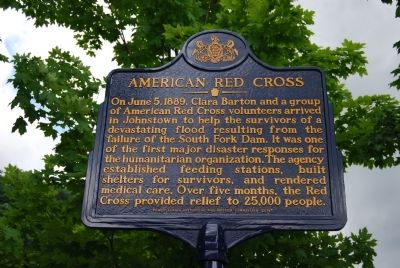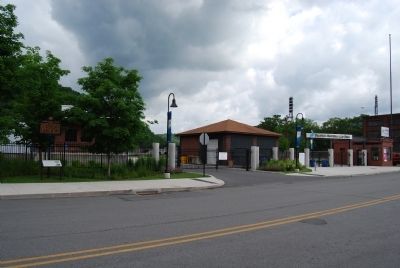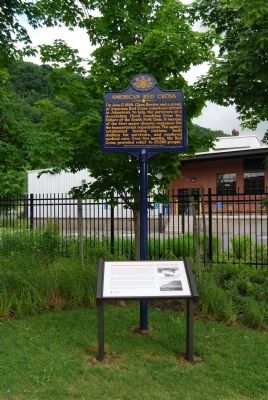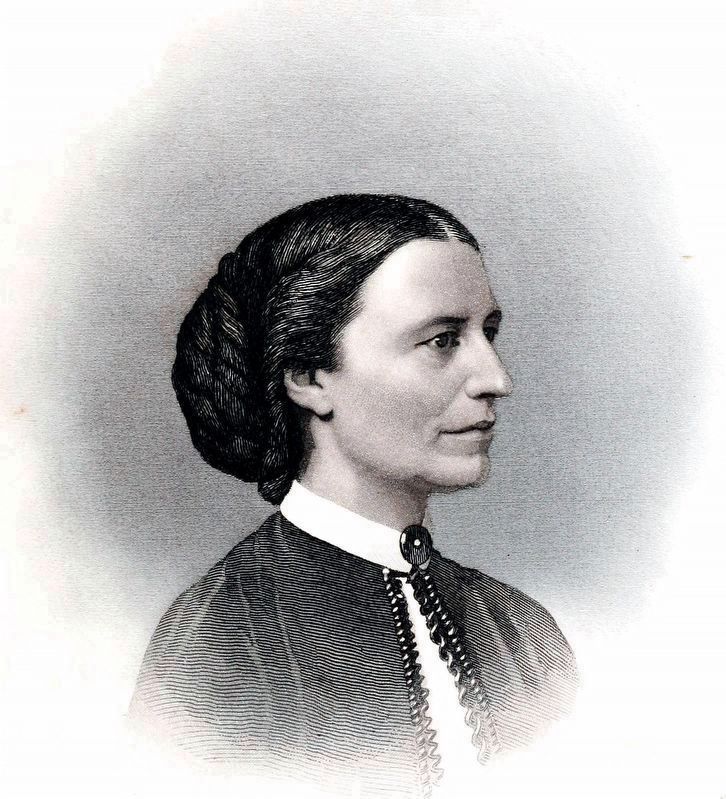Johnstown in Cambria County, Pennsylvania — The American Northeast (Mid-Atlantic)
American Red Cross
Erected 2014 by Pennsylvania Historical and Museum Commission.
Topics and series. This historical marker is listed in these topic lists: Charity & Public Work • Disasters • Science & Medicine. In addition, it is included in the Clara Barton, and the Pennsylvania Historical and Museum Commission series lists. A significant historical month for this entry is June 1924.
Location. 40° 19.789′ N, 78° 55.407′ W. Marker is in Johnstown, Pennsylvania, in Cambria County. Marker is at the intersection of Johns Street and Walnut Street, on the right when traveling south on Johns Street. Located at Peoples Natural Gas Park. Touch for map. Marker is in this post office area: Johnstown PA 15909, United States of America. Touch for directions.
Other nearby markers. At least 8 other markers are within walking distance of this marker. Johnstown Flood (within shouting distance of this marker); Johns Street Bridge (within shouting distance of this marker); Johnstown Local Flood Protection Project (about 400 feet away, measured in a direct line); Flood Prevention (about 400 feet away); Pennsylvania Railroad Stone Bridge (about 400 feet away); A Success Story (about 500 feet away); Walnut Street Bridge (approx. 0.2 miles away); Oklahoma House (approx. 0.2 miles away). Touch for a list and map of all markers in Johnstown.
Also see . . .
1. Official site of the American Red Cross. (Submitted on June 14, 2014, by Mike Wintermantel of Pittsburgh, Pennsylvania.)
2. Clarissa Harlowe "Clara" Barton at FindAGrave.com. (Submitted on June 14, 2014, by Mike Wintermantel of Pittsburgh, Pennsylvania.)
3. Johnstown Flood History, Videos, and Pictures. (Submitted on June 14, 2014, by Mike Wintermantel of Pittsburgh, Pennsylvania.)
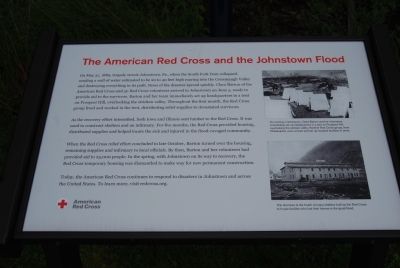
Photographed By Mike Wintermantel, June 14, 2014
4. American Red Cross and the Johnstown Flood sign
On May 31, 1889, tragedy struck Johnstown, Pa., when the South Fork Dam collapsed, sending a wall of water estimated to be 20 to 40 feet high roaring into the Conemaugh Valley and destroying everything in its path. News of the disaster spread quickly. Clara Barton of the American Red Cross and 50 Red Cross volunteers arrived in Johnstown on June 5, ready to provide aid to the survivors. Barton and her team immediately set up headquarters in a tent on Prospect Hill, overlooking the stricken valley. Throughout the first month, the Red Cross group lived and worked in the tent, distributing relief supplies to devastated survivors.
As the recovery effort intensified, both Iowa and Illinois sent lumber to the Red Cross. It was used to construct shelters and an infirmary. For five months, the Red Cross provided housing, distributed supplies and helped locate the sick and injured in the flood-ravaged community.
When the Red Cross relief effort concluded in late October, Barton turned over the housing, remaining supplies and infirmary to local officials. By then, Barton and her volunteers had provided aid to 25,000 people. In the spring, with Johnstown on its way to recovery, the Red Cross temporary housing was dismantled to make way for new permanent construction.
Today, the American Red Cross continues to respond to disasters in Johnstown and across the United States. To learn more, visit redcross.org.
Top Photo
On arriving in Johnstown, Clara Barton and her volunteers immediately set up headquarters in a tent on Prospect Hill, overlooking the stricken valley. Another Red Cross group, from Philadelphia, soon arrived and set up hospital facilities in tents.
Bottom Photo
This structure is the fourth of many shelters built by the Red Cross to house families who lost their homes to the great flood.
As the recovery effort intensified, both Iowa and Illinois sent lumber to the Red Cross. It was used to construct shelters and an infirmary. For five months, the Red Cross provided housing, distributed supplies and helped locate the sick and injured in the flood-ravaged community.
When the Red Cross relief effort concluded in late October, Barton turned over the housing, remaining supplies and infirmary to local officials. By then, Barton and her volunteers had provided aid to 25,000 people. In the spring, with Johnstown on its way to recovery, the Red Cross temporary housing was dismantled to make way for new permanent construction.
Today, the American Red Cross continues to respond to disasters in Johnstown and across the United States. To learn more, visit redcross.org.
Top Photo
On arriving in Johnstown, Clara Barton and her volunteers immediately set up headquarters in a tent on Prospect Hill, overlooking the stricken valley. Another Red Cross group, from Philadelphia, soon arrived and set up hospital facilities in tents.
Bottom Photo
This structure is the fourth of many shelters built by the Red Cross to house families who lost their homes to the great flood.
Credits. This page was last revised on February 14, 2018. It was originally submitted on June 14, 2014, by Mike Wintermantel of Pittsburgh, Pennsylvania. This page has been viewed 852 times since then and 22 times this year. Photos: 1, 2, 3, 4. submitted on June 14, 2014, by Mike Wintermantel of Pittsburgh, Pennsylvania. 5. submitted on February 11, 2018, by Allen C. Browne of Silver Spring, Maryland.
